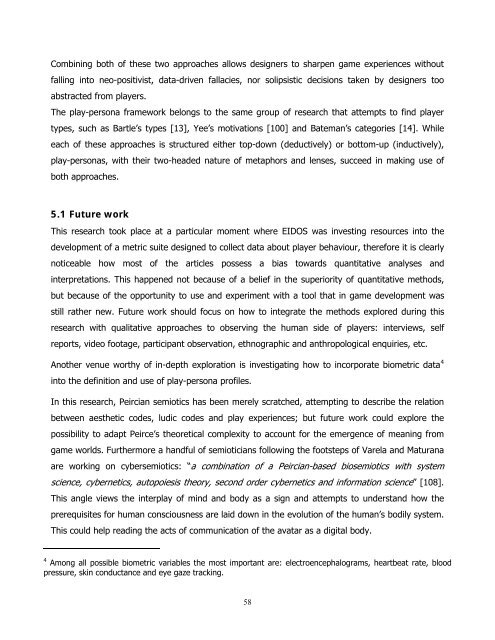Play-Persona: Modeling Player Behaviour in Computer Games
Play-Persona: Modeling Player Behaviour in Computer Games
Play-Persona: Modeling Player Behaviour in Computer Games
Create successful ePaper yourself
Turn your PDF publications into a flip-book with our unique Google optimized e-Paper software.
Comb<strong>in</strong><strong>in</strong>g both of these two approaches allows designers to sharpen game experiences without<br />
fall<strong>in</strong>g <strong>in</strong>to neo-positivist, data-driven fallacies, nor solipsistic decisions taken by designers too<br />
abstracted from players.<br />
The play-persona framework belongs to the same group of research that attempts to f<strong>in</strong>d player<br />
types, such as Bartle’s types [13], Yee’s motivations [100] and Bateman’s categories [14]. While<br />
each of these approaches is structured either top-down (deductively) or bottom-up (<strong>in</strong>ductively),<br />
play-personas, with their two-headed nature of metaphors and lenses, succeed <strong>in</strong> mak<strong>in</strong>g use of<br />
both approaches.<br />
5.1 Future work<br />
This research took place at a particular moment where EIDOS was <strong>in</strong>vest<strong>in</strong>g resources <strong>in</strong>to the<br />
development of a metric suite designed to collect data about player behaviour, therefore it is clearly<br />
noticeable how most of the articles possess a bias towards quantitative analyses and<br />
<strong>in</strong>terpretations. This happened not because of a belief <strong>in</strong> the superiority of quantitative methods,<br />
but because of the opportunity to use and experiment with a tool that <strong>in</strong> game development was<br />
still rather new. Future work should focus on how to <strong>in</strong>tegrate the methods explored dur<strong>in</strong>g this<br />
research with qualitative approaches to observ<strong>in</strong>g the human side of players: <strong>in</strong>terviews, self<br />
reports, video footage, participant observation, ethnographic and anthropological enquiries, etc.<br />
Another venue worthy of <strong>in</strong>-depth exploration is <strong>in</strong>vestigat<strong>in</strong>g how to <strong>in</strong>corporate biometric data 4<br />
<strong>in</strong>to the def<strong>in</strong>ition and use of play-persona profiles.<br />
In this research, Peircian semiotics has been merely scratched, attempt<strong>in</strong>g to describe the relation<br />
between aesthetic codes, ludic codes and play experiences; but future work could explore the<br />
possibility to adapt Peirce’s theoretical complexity to account for the emergence of mean<strong>in</strong>g from<br />
game worlds. Furthermore a handful of semioticians follow<strong>in</strong>g the footsteps of Varela and Maturana<br />
are work<strong>in</strong>g on cybersemiotics: “a comb<strong>in</strong>ation of a Peircian-based biosemiotics with system<br />
science, cybernetics, autopoiesis theory, second order cybernetics and <strong>in</strong>formation science” [108].<br />
This angle views the <strong>in</strong>terplay of m<strong>in</strong>d and body as a sign and attempts to understand how the<br />
prerequisites for human consciousness are laid down <strong>in</strong> the evolution of the human’s bodily system.<br />
This could help read<strong>in</strong>g the acts of communication of the avatar as a digital body.<br />
4<br />
Among all possible biometric variables the most important are: electroencephalograms, heartbeat rate, blood<br />
pressure, sk<strong>in</strong> conductance and eye gaze track<strong>in</strong>g.<br />
58















